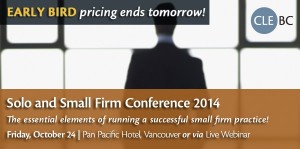♫ If you should see me walking
Through your dreams at night
Would you please direct me
Where I ought to be
I’ve been looking for a crystal ball
To shed the light
To find a future in me…
To find a future in me…♫
Lyrics and Music by: Tommy Shaw, recorded by Styx.
To say that we have been thru a tremendous time of change in the legal profession is a wee bit of an understatement. Furthermore I believe that the rate of change is accelerating. This means that the changes that are coming at us like a Tsunami are totally unprecedented. New competitors, new business structures, new technology, new ways of resolving disputes, new ways of communicating, new devices and services…there is hardly a corner of the legal profession that will not be impacted. Then there are all the pressures from outside the legal profession to increase access to justice and bring the legal system within reach of the man on the Clapham Omnibus. Of course a tremendous time of change is also a tremendous time for opportunity.
Last year we heard from:
- Jordan Furlong
- Ross Fishman
- Sharon Nelson
- Ann Halkett
- Richard Granat
- Nicole Black
- Colin Rule
- Brian Mauch
- John Zeleznikow
- Michael Downey
- Robert Denney
- Mitch Kowalski
- Buzz Bruggeman
- Andrew Clark
- UnitedLex
- and yours truly!
It is precisely at this juncture that I am calling on my friends, colleagues and readers to submit their predictions for 2015 in order that all of us can benefit by the collective thoughts and gaze into the crystal ball to shed the light ..and see where we stand …in order to find a future in all of us..
♫ Inch by inch, row by row, I’m gonna make this garden grow
All it takes is a rake and a hoe and a piece of fertile ground…♫
Lyrics and music by: David Mallett, recorded by: Peter, Paul & Mary.
Abraham Lincoln is credited with saying: “The best way to predict your future is to create it”
Brian Tracy in his blog talks about the Golden Hour – a time that you set aside at the start of your day to work on the most important task you will have for your lifetime – namely your personal development.
Brian states:
[T]ake 30-60 minutes and read something motivational, inspirational or educational. Be sure that the first thing you put into your mind in the morning is positive, healthy and consistent with the kind of life you want to lead.
A colleague of mine, Tom Grella, has been following this philosophy for as long as I have known him. He takes an hour a day to read books and study leadership as it applies to lawyers. His time invested in this activity has paid off in spades.
Tom, the managing partner of McGuire, Wood & Bissette in Asheville, N.C., in 2012 was named the recipient of the Samuel S. Smith Award by the American Bar Association’s Law Practice Management Section.
“I cannot think of a more deserving honoree than Tom Grella. He epitomizes everything this award was created to recognize,” said Thomas Mighell, chair of the ABA Law Practice Management Section. “Tom stands out as a leader in LPM, the ABA and his law firm. His commitment to the improved growth and education of law practice management is steadfast, as demonstrated through his continued participation and leadership in LPM section activities.”
The lesson here is to start – today – in investing in yourself to become the person that you wish to be. Inch by inch, day by day, you will be making progress towards your goal.
Brian Tracy has great advice on how to make this happen. He says:
After you have completed your morning reading, take a spiral notebook and write out your top 10-15 goals in the present tense, exactly as if you have already achieved them. Write goals such as, “I earn $100,000 per year”; “I weigh 165 pounds and am superbly fit”; “I drive a brand new grey BMW”; “I live in a beautiful 3500 square foot home” and so on. Rewrite your list of goals every morning without referring back to the goals you wrote the day before. This is a very important success factor for you to practice in order to achieve your goals.
Only you will know what your goals are.. eHow says:
Think about what you value in life. Your goals and aspirations need to be in line with your values in life. Defining your values will help you to set a direction for your goals and keep you focused and on track.
Your goals can be as big and as broad as your imagination. They could be to help your family and your children excel. They could be to make your business succeed. They could be to build your relationship with your spouse to be strong and powerful. Or they can aspire to achieve world peace and help end hunger.
As Ralph Waldo Emerson said: “Dare to live the life you have dreamed for yourself. Go forward and make your dreams come true.”
(cross-posted to tips.slaw.ca)
♫ Boy, you’re going to carry that weight,
Carry that weight a long time
Boy, you’re going to carry that weight
Carry that weight a long time…♫
Lyrics and Music by Lennon & McCartney recorded by The Beatles.
This is a guest post from Ann Mehl and originally appeared in her Newsletter and blog under the title “The High Note“. To say that it struck a note is putting it mildly. I hope you find it to be as moving and reflective as I did. It is reproduced here with her approval and consent.
While scanning the radio in my car for a good song, I stumbled upon an interview with Paul McCartney. He was funny and engaging, so I stopped to listen for a while. He was asked about his voice, and if, at age 71, he could still sing all those old Beatles songs. His answer was honest and revealing. “Well,” he said. “I can’t hit all the high notes like I used to, but I’ve probably got better technique now, and you learn ways around that.” Some of those techniques? Changing the melody ever so slightly, letting his back up singers hit the high notes for him, or simply calling upon his audience fill in the blanks. Music legend Sir Paul McCartney has had to learn that even he has musical limitations.
This got me thinking: How much of our lives are spent trying to chase a high note that we are no longer capable of hitting? And what does this cost us in terms of health and happiness? In my own life, I know I hit a high note when I ran my first marathon at 3:26, a personal record for me. It’s unlikely I will ever do it again, and that’s okay. I’m interested in different goals now. But it can be very hard to let go of who we used to be, or who we imagine we still are. We see it all the time in professional sports: the athlete who retires, only to “unretire” six months later. The boxer who wants “one more fight” when everyone around him knows he should have quit years ago.
Most of us are not athletes or professional performers, but we do know what it’s like to chase our former glories, and to hunger for that intoxicating high note. Maybe it’s the version of ourselves that is 10 years younger, or 20 pounds lighter. Maybe it’s the earlier excitement of a new job, or the rush of a new romance. Most of us yearn for these peak experiences, and once experienced, seek to recreate them.
That’s not necessarily a bad thing, but it can lead to a lot of frustration and heartache in the present. The problem with chasing only these moments, is that they are generally very fleeting, if they exist at all. And we can miss out on some of the really great moments happening in between. Martina Navratilova said it best: “The moment of victory is much too short to live for that and nothing else.”
I knew of one serial entrepreneur who made a killing on his first venture, to the tune of almost $10 million. He went on to create several other successful companies after this, but none as big as the first. Measured against this impossible standard, he felt he was constantly failing, even when, by all outward signs he was a massive success. To his family and work colleagues, he had become a bitter pill who could not enjoy his own success. He was enslaved to the high note, in his case, some arbitrary number below which anything spelled failure. He was Sisyphus, compelled to roll an immense boulder uphill, only to become demoralized every time it rolled back down on top of him.
There are two basic roads that we can travel: one is the road to freedom, and the other is the road to tyranny. The road to tyranny is based on always hitting the high note, and a refusal to accept anything else. It enslaves us to the past, and blinds us to new opportunities in the present. After all, who are we if we can no longer hit the high note? The road to freedom, on the other hand, accepts that all things are in a constant state of flux: our bodies, our minds, our relationships. What we are able to do in our 20s and 30s is very different from what we can do in our 40s, 50s and beyond. And not only is this okay, it is natural.
At the root of all unhappiness is our refusal to accept that all things eventually must end: our youth, our beauty and eventually even ourselves. What we are really fighting against is our own mortality, and that is one battle we will never win. But like Paul McCartney, maybe we can learn some new techniques. We can accept that while a relationship has changed, it does not necessarily have to end. We can accept that while a job is no longer as exciting as it once was, it may offer its own kind of reward in the people we meet. We can accept that through age or infirmity, a parent is no longer the person we once knew, and try to develop a new connection based on who they are now.
I’m not suggesting we give up or don’t stretch ourselves, only that we don’t have to be slaves to our past successes (or failures). Graceful surrender to the here and now is always preferable to screeching, or God forbid, ruptured vocal chords. Paul McCartney may not be able to hit the high notes like he used to. All he can do is make friends with the voice he has now, and the many beautiful notes he still can sing. And when the voice cracks, or won’t go where he wants it to go, he invites the audience to sing along.
—
Thanks Ann for reminding us that unless we learn to gently acknowledge and adjust to the fact that we may not be able to hit the high notes like we used to, we will be carrying that weight a long time…
(Hat tip to Stewart Levine for originally drawing my attention to Ann’s article).
Thought for the Day: “In the end, the love you take is equal to the love you make” – Paul McCartney.
♫ You’re a leftover
Pastrami on rye
Succulent and delicious
Yes, the sandwich of my eye…♫
Lyrics, music and recorded by Hot Soda Apparatus.
 I read an article today in Slate Magazine entitled “The UR-Deli – How Katz’s stays in business against the odds by Jordan Weissmann.” This article is about how Katz’s deli in New York City has remained in business in the lower east side of New York since 1888 while its competitors have failed.
I read an article today in Slate Magazine entitled “The UR-Deli – How Katz’s stays in business against the odds by Jordan Weissmann.” This article is about how Katz’s deli in New York City has remained in business in the lower east side of New York since 1888 while its competitors have failed.
The business model is to deliver a hefty pastrami on rye for $19.75. Believe it or not, that sandwich is not much of a moneymaker. The old-style delis are facing a conundrum: the very thing that makes them loved..those wonderful stacked pastrami and corned beef sandwiches – is the thing that makes it hardest from an economic standpoint. They don’t make much money.
Compare and contrast that with law firms: the very thing that makes us loved – delivering bespoke legal services – is the very thing that makes it hardest from an economic standpoint. We can’t seem to deliver legal services at a lower cost. We are facing a basic economic issue similar to these old delis…
How does Katz’s deli survive?
The reason Katz’s was able to live on while its competitors disappeared largely boils down to real estate. As Sax writes in Save the Deli, New York’s delicatessens can basically be divided into two groups: those that rent their buildings and those that own. Famous renters, like the Stage Deli and 2nd Avenue Deli, have closed in the face of rent hikes. Famous owners, like Carnegie and Katz’s, have lived on. (And when 2ndAvenue Deli reopened, it bought a building … on New York’s 3rd Avenue). If Katz’s had to deal with a landlord, it would likely have disappeared or moved long ago.
Is there a lesson here for law firms? Could – possibly – part of the solution to the access to justice issues be that law firms start owning their own office buildings? There are a number of advantages arising from this model. The partners of such a firm would be building equity in the property over time; that same equity could be used to retire older partners when newer partners purchase an interest in the business as well as the real estate asset. Keeping ownership of the office space may reduce the overhead costs that could help the firm render legal services to a broader base of clients.
Certainly the issue of trying to broaden the ability of existing law firms to deliver legal services economically to a wider group of society does not have any easy solutions. However, perhaps Katz’s and similar survivors have lessons for us today. Notwithstanding we are a leftover, perhaps we can still be the sandwich in a client’s eye…
♫ Our contribution to the revolution…♫
Lyrics and Music by Michael Jacobs and Patrick Regan, recorded and Created by Lucent Technologies Public Relations (2000) (this has got to be the geekiest music video I have ever seen!)
Roger Smith
This is a guest post from Richard Zorza on his blog: Richard Zorza’s Access to Justice Blog. It is a very thoughtful piece about innovation here in British Columbia by the Legal Services Society when faced by massive budget cuts, as compared to what has been done elsewhere (such as the UK) when faced with a similar situation. This blog post follows Roger Smith’s recent visit to us here in BC (where I was fortunate enough to have a fascinating lunch with Roger and others at the LSS offices) and Roger’s own blog post (mentioned herein) on this topic. Hat tip to Erin Shaw, a lawyer who has an extensive background in policy analysis, dispute resolution and justice and law reform, for pointing this post to me this last friday in Victoria! This post is reproduced with the kind permission of the author.
I want to draw your attention to a blog post by the UK’s wonderful Roger Smith contrasting the BC and UK approach to cutting, and response to cuts in, legal aid budgets. His essential point is that the BC cuts, while apparently just as draconian, were structured to allow for flexibility and innovation, and the challenges were approached in that spirit.
A couple of paras of contrast from the post:
The crucial difference between our [UK] position and that of BC is that, unlike by Chris Grayling and the Legal Aid Administration, cuts were not seen as an end in themselves. Yes, the government wanted blood but, provided legal aid could work within a reduced budget, then its administration was left free to do the best that it could. At first, the extent of the slaughter left little wriggle room and lawyers still argue that they should have been the first beneficiaries of any discretionary cash. But, the Legal Services Society, the legal aid administrator, has gradually sought to re-engineer its purpose as not only to provide representation in core cases but to deliver self help and advice designed to assist people to resolve legal problems on their own.
The difference a decade after BC’s cuts is that I have come all the way to Vancouver to see the brilliant work that the Legal Services Society, the Justice Education Society and the Courhouse Libraries are providing in digital delivery to those on low incomes. Google clicklaw.bc.ca, families change.ca, familylaw.lss.bc.ca (soon to be mylawbc.org) for a host of cutting edge provision in the province. Even the Ministry of Justice is joining in. Legislation in 2012 allows the funding of an online small claims court, the civil resolution tribunal, which will come on stream next year. Try even to file an electronic document in our own dear courts. No chance. No imagination. No innovation. Just a Minister and a Ministry shorn of any interest save in reducing expenditure. Cuts, Mr Grayling, are the easy part. Making sense – or even the best – of them takes imagination and innovation. Get on a plane; meet your BC counterparts and be appropriately humble about your government’s limited imagination and barren approach to policy.
In some ways, the cuts in these jurisdictions put them roughly where the US is now. So the question is whether we approach digging ourselves out of the access crisis with the same creativity. Or are we only nibbling at the edge of change. Inevitably, in the US the answer is “it depends” usually on the state and on the quality of leadership in the state. But I fear that our fragmentation means that we lack national leadership on things like a broad roll-out of self-help centers, forms, unbundling, and the other elements of the continuum of services, and all the quality and cost benefits that would come from national strategies. An exception is special kudos to LSC, Pro Bono Net and others for creating a near-national network of websites (although all would agree that the integration could go much further particularly on the marketing/partnering end.)
I hope that we as delivery innovators never forget that there will always be cases in which lawyers are needed — even as we work through simplification and innovation in both community based and court-based legal aid to reduce that percentage. But I also urge right to counsel folks not to forget that explicitly or implicitly taking the position that lawyers are always needed makes their proposals far more expensive and both politically and legally much more likely to build resistance. It’s an interesting question how the recent Boston Bar (article) (Report) and Maryland Right to Counsel reports deal with this challenge.
The key, of course, is triage and the key to the politics of a solution to the differences in perspective is common research and understanding about triage.
p.s. There is a newly updated website on right to counsel developments, including an interactive map, recently launched by the Coalition.
—
I hope you have enjoyed this little contribution to the revolution! Thanks Roger, Richard and Erin!
♫ I want you
Do you want me too?
I have one question
Can I help you?
Now watch me, what I do
Now thank you for coming through my drive-thru..♫
Lyrics and Music by: Julian Casablancas, Santi White, Pharrell Williams, recorded by Julian Casablancas, Santigold, and Pharrell Williams.
In the four prior posts in this series, we looked at how price is just one of seven components of the legal marketing mix. Part 2 discussed the product mix – and how changing your product mix may result in a great match between your services and the needs of the clients. Part 3 looked at who was on your team and how they deliver your services – and how this can have a big distinguishing effect on how clients view your services against the competition. In Part 4 we looked at promotion and how this can make your services stand out from the pack. In each of these posts we have looked at how each of these components helps distinguish your services from the competition; services that are distinguishable are priced differently, as they are no longer comparable with the competition.
In this post we are looking at yet another component of the marketing mix – namely the place where you deliver your services. Just consider the range of physical office configurations – from storefront offices on main street to walkup offices to Class A office space in a gleaming skyscraper. Each one of these sends an unwritten message to a potential consumer of legal services. Furthermore, you can practice as a solo, in an office sharing arrangement, an associate or a partner of a firm, large or small. Lawyers can maintain branch offices in the suburbs, in another town, province or state or even another country or continent. You can be a travelling lawyer who attends clients at their places of business, home, hospital, care facility, union hall or even a Starbucks. You can offer handicap access or after-hour access. Lastly but certainly not least, you can maintain a virtual office, using internet technologies to meet, share, collaborate and meet the needs of your clients who could be down the street, across town, in a distant city or even across the world. The range of possibilities are unbounded.
Indeed, bold lawyers have envisioned practising in ways that break the familiar constraints. Axess Law in Ontario has launched law offices that are embedded within Wal*Mart stores in Ontario and offer home, family, business services, legal contracts and notary services in an affordable and approachable context.
The range of offices and services that can be offered from different locations to meet client needs is as open and wide as your imagination. Perhaps one day a lawyer will open an office where a client can receive legal advice right in their car…and the lawyer would say…”Can I help You?” and then conclude with: “Thank you for coming thru my drive-thru…”
(cross-posted to tips.slaw.ca)
♫ That’s why I fell for (the leader of the pack)…♫
Lyrics and Music by: George “Shadow” Morton, Jeff Barry and Ellie Greenwich, recorded by The Shangri-Las.
In the three prior posts on lawyers and pricing, we have looked at how price is only one part of the 7 components of the legal marketing mix. Part 2 discussed the product mix and how you can change your legal product mix to better meet the needs of your clients in a way that distinguishes your services from those of the competition. Part 3 examined how the people on your team can have a big impact on how your services are delivered. In fact, in Good to Great, Jim Collins said that the most important factor applied by the best companies is that they first of all “Got the right people on the bus, and the wrong people off the bus.” In this post we are exploring how promoting your business can be a distinguishing feature, setting your business up as being different from the competition…allowing you to price your services differently from the competition.
Think about all the different ways that your clients learn about your services. Certainly word-of-mouth is the gold standard of referral marketing, but not everyone who is a client in your firm came in the doors as a result of a personal referral. When it comes to marketing your practice, the one truth is that whatever works today will stop working at some time in the future for reasons that you might never know. Accordingly you need to change up your promotional or marketing activities and keep trying new things. Small changes can have big effects.
Social media is all the rage today and for good reason. Facebook has now reached 1.3 billion people – and that doesn’t include anyone in China! LinkedIn and Twitter are the other members of the “big three” social media networks. Have a look at your Facebook page, your LinkedIn profile and your use of Twitter. You can choose to not be on any of these (after all you can choose how to market your firm and your practice) and if these wouldn’t resonate for you or your clients ..fair ball. What is worse is being there but not having updated anything for some time. This indicates lack of commitment and follow-thru. Same goes for a blog – I personally find blogging to be one of the easiest and more effective ways for a young lawyer to establish themselves and their expertise in the market, if done consistently and well. Combine a blog with your thoughtful use of twitter on developments in your legal area of choice and you can become known as an authority in short order. For a great overview of how Canadian lawyers are blogging see the Clawbies website – the Canadian Legal Blog awards. You can be as creative as your imagination will take you..provided you still stay within the marketing ethics of your jurisdiction.
If social networking is not for you, there are a host of more traditional marketing methods. In person presentations and webinars are one way to get known and demonstrate your knowledge of your area of practice. Financial institutions are always putting on presentations. If writing is your thing, then offer to do a regular column in a local or community newspaper (you can then reuse these articles in a blog or newsletter). You can clearly show your involvement and interest in local affairs, schools, sporting events, churches and other organizations and help them – thereby building your presence in the community.
Whatever you do, try to ensure that your marketing makes you stand out from the pack. After all that is its purpose – to show that you are different from the rest. You want your clients to have fallen for the leader of the pack.
(cross-posted to slaw tips.ca)
♫ I only need to tell myself
See what the future holds… ♫
Lyrics, music and recorded by S.P.Y.
Just a note that the 2014 Solo and Small Firm Conference early bird rate ends tomorrow…!!
This is a CLE-BC conference and we have worked quite hard on the content and the speakers. This is for anyone running or in a solo or small firm practice or thinking of launching one.
This is the latest in a series of Solo and Small Firm Conferences that have been hosted by CLE-BC. It only comes around every 2 years.
We have outstanding speakers including the Past President of the CBA Fred Headon doing the lunch keynote on the implications of the CBA Futures Report for solo and small firms (by Skype!).
You can attend in person or virtually.
Topics include Business School for Lawyers – what they didn’t teach you in Law School; Managing the Finances – Making the Numbers Work, Law Office Management and Technology, Marketing Ethically, Dealing with the Self Represented and Freeman on the Land, Solo and Small Firm issues and a guest presentation by the founders of the Axess Law Firm in Ontario – who have ’embedded’ a law practice inside a number of Wal*Mart stores in Ontario.
This is a fresh look at solo and small firm practice…and an exciting one.
As the conference chair, I welcome you to the conference and I am looking forward to seeing you all there. Come and see what the future holds!
♫ I want to be part of the solution
Can you use me to lead a revolution?
I want to be part of the solution… ♫
Music, Lyrics and recorded by: Jonah33.
The issues facing the profession have been set out by many: from Richard Susskind as documented in his many books, to Madam Justice McLachlin, who has said:
“Timely, effective access is the most pressing issue facing Canada’s justice system, says Supreme Court Chief Justice Beverley McLachlin.
Many people have given up on seeking justice through the courts, deterred by the often expensive and time consuming process, she said.
…
“We do need some new approaches…we need to get behind the solutions,” she said.
The problems facing the justice system and the legal profession are well set out. The issue is where are the solutions to come from? More importantly, where will the leadership come from?
The Canadian Bar Association has now published its comprehensive August 2014 report, Futures: Transforming the Delivery of Legal Services in Canada. This report is the culmination of two years of consultation, original research and analysis on the future legal marketplace in Canada, and includes a series of recommendations on where and how the profession can transform itself. (See more at: http://www.cbafutures.org/reports#sthash.NMcwadWx.dpuf)
The hardest issue, as I see it, will be in implementing the recommendations that have been brought forward. Implementation of change is always the hardest part of any process. Here the law schools are facing a critical juncture: do they help lead the change to meet the new challenges – or – do they stand in the way of change?
In an article in The New Republic entitled “How to Fix Law School” (http://www.newrepublic.com/article/113983/how-fix-law-school-symposium) Mike Kinsley says:
“When you graduate, you should be prepared to pass the bar. The discovery that everything you have crammed into your head for three years has no relevance at all, and you have to master a whole new curriculum in just a few weeks for the bar exam, is dispiriting.
It’s absurd that you can graduate from law school without ever seeing a real client. Some clinical courses ought to be mandatory. Trainee doctors start seeing real patients within a year and a half. Trainee lawyers can go three, and graduate, without ever touching a client. And, let’s be honest, the training of your doctor is more important.”
I think law schools need to lead the change that we wish to see in the profession. It all starts here, from the training of lawyers to practice law (including training on issues such as practice management, actually running a business and using legal technology) to how to manage clients and actually do a conveyance, an incorporation or a decently drafted will. We need law schools to think differently.
Most of all, we need law schools to teach law students to be leaders who can step up and continue this process of change in order that the legal profession remains a strong, independent profession and continues to serve the needs of the community.
We need leadership in the profession and this training must start in law school. Law schools need to fully embrace being part of the solution in leading the revolution. In my view we don’t need any more law schools in this country that train lawyers in the old ways of doing things. What we need are the existing law schools to produce graduates that are going to be leaders in moving the profession forward with new approaches, new technologies and new ways of thinking – we need law schools to be part of the solution.
(Article has been updated. The original was published in CBA’s publication BarTalk).
♫ Well, rave on it’s a crazy feeling
And I know it’s got me reeling
I’m so glad that you’re revealing your love for me…♫
Lyrics and music by: Shaun Ryder, Paul Richard Davis, Mark Philip Day, Paul Anthony Ryder, Gary Kenneth Whelan, recorded by Buddy Holly.
In the prior two posts on lawyers and pricing, we have been discussing the issue that price is but one part of the 7 components of the legal marketing mix. Part 2 discussed the product mix and how you can change your legal product mix to better meet the needs of your clients in a way that distinguishes your services from those of the competition. In this post we are exploring how important the people who deliver your legal services are and how this can be a distinct competitive advantage.
All of us have experienced situations where your first contact with a business is with someone who just makes you feel like looking after you is the most important thing for them to do in their day. I had that experience today – I called a law firm and spoke to an assistant who, when I asked to speak to her principal, said in the most caring voice: “Well, he isn’t in his office right now but let me go out and round him up for you.” This was my very first contact with this firm and this wonderful lady didn’t know me from Adam. The way she made me feel was simply amazing. She made me feel valued and important. I recognized her exceptional people skills and thought about how she was a tremendous asset to the firm.
In Good to Great, Jim Collins said that the most important factor applied by the best companies is that they first of all “Got the right people on the bus, and the wrong people off the bus.” In other words, your ability to select, recruit, train and retain the best people with the skills and abilities to do the job right is more important than everything else put together.
The Spectacled Marketer says:
If a customer feels their expectations of your business are exceeded, then the chances of a referral are exponentially increased because their loyalty to your company is exponentially increased as well!
You need to strive for your clients to feel exceptionally satisfied so that they rave about your services. How do you exceed your client’s expectations? The first step is …hold on now…ask them! Yet lawyers and law firms *shudder* at the thought of asking clients three simple questions:
- What did they like about the firm’s services,
- What didn’t they like, and
- How could the firm firm do it better.
If you find out that there is someone on your bus that shouldn’t be there…you have a decision to make. If you find out that you have someone on your bus who is simply exceptional and is a tremendous asset to your firm, make sure you recognize and reward them accordingly!
In considering the marketing of your practice, consider how the people in your business can either make your clients rage on, feel indifferent, feel satisfied or preferably, rave on about your services. Your client service can be a strong distinguishing factor as compared to your competition. In terms of your marketing mix, strive for having very satisfied clients showing their “love by raving on about you!”
(cross posted to www.tips.slaw.ca)



























